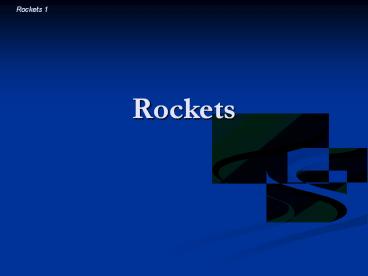Rockets - PowerPoint PPT Presentation
Title:
Rockets
Description:
Stability and Orientation On the ... Question 2 Rocket Engines Question 3 Stability and Orientation Question 4 Ship s Ultimate Speed Question 5 Gravity ... – PowerPoint PPT presentation
Number of Views:273
Avg rating:3.0/5.0
Title: Rockets
1
Rockets
2
Introductory Question
- If there were no launch pad beneath the space
shuttle at lift-off, the upward thrust of its
engines would be - approximately unchanged.
- approximately half as much.
- approximately zero.
3
Observations about Rockets
- Plumes of flame emerge from rockets
- Rockets can accelerate straight up
- Rockets can go very fast
- The flame only touches the ground initially
- Rockets can apparently operate in empty space
- Rockets usually fly nose-first
4
6 Questions about Rockets
- What pushes a rocket forward?
- How does the rocket use its gas to obtain thrust?
- What keeps a rocket pointing forward?
- What limits a rockets speed, if anything?
- Once in space, does a spaceship have a weight?
- What makes a spaceship orbit the earth?
5
Question 1
- What pushes a rocket forward?
6
Momentum Conservation
- A rockets momentum is initially zero
- That momentum is redistributed during thrust
- Ship pushes on fuel fuel pushes on ship
- Fuel acquires backward momentum
- Ship acquires forward momentum
- Rockets total momentum remains zero
7
Rocket Propulsion
- Neglecting gravity, then
- rockets total momentum is always zero
- momentumfuel momentumship 0
- The momenta of ship and fuel are opposite
- The ships momentum is equal but opposite to
- the velocity of the fuel
- times the mass of that fuel
8
Introductory Question (revisited)
- If there were no launch pad beneath the space
shuttle at lift-off, the upward thrust of its
engines would be - approximately unchanged.
- approximately half as much.
- approximately zero.
9
Question 2
- How does the rocket use its gas to obtain thrust?
10
Rocket Engines
- Combustion produces hot, high-pressure gas
- The gas speeds up in a de Laval nozzle
- Gas reaches sonic speedin the nozzles throat
- Beyond the throat, supersonicgas expands to
speed up further
11
Question 3
- What keeps a rocket pointing forward?
12
Stability and Orientation
- On the ground, a rocket needs static stability
- In the air, a rocket needs aerodynamic stability
- Center of aerodynamic forces behind center of
mass - In space, a spaceship is a freely rotating object
- Orientation governed by angular momentum
- Small rockets are used to exert torques on
spaceship - Spaceships orientation doesnt affect its travel
13
Question 4
- What limits a rockets speed, if anything?
14
Ships Ultimate Speed
- Increases as
- the ratio of fuel mass to ship mass increases
- the fuel exhaust speed increases
- If fuel were released with the rocket at rest,
- Because rocket accelerates during thrust,
ultimate speed is less than given above
15
Question 5
- Once in space, does a spaceship have a weight?
16
Gravity (Part 1)
- The earths acceleration due to gravity is only
constant for small changes in height - When the distance between two objects changes
substantially, the relationship is
17
Gravity (Part 2)
- The ships weight is only constant for small
changes in height - When the ships height changes significantly
18
Gravity (Part 3)
- Even far above earth, an object has weight
- Astronauts and spaceships have weights
- weights are somewhat less than normal
- weights depend on altitude
- Astronauts and spaceships are in free fall
- Astronauts feel weightless because they are
falling
19
Question 6
- What makes a spaceship orbit the earth?
20
Orbits (Part 1)
- An object that begins to fall from rest falls
directly toward the earth - Acceleration and velocityare in the same
direction
21
Orbits (Part 2)
- An object that has a sideways velocity follows a
trajectory called an orbit - Orbits can be closedor open, and areellipses,
parabolas,and hyperbolas
22
Current Rocket Technology
- X-Prize Rockets
- Single State to Orbit Rockets
- Improbable Dreams
- Rockets that rarely require refueling
- Rockets that can land and leave large planets
- Rockets that can turn on a dime in space
23
Summary About Rockets
- Rockets are pushed forward by their fuel
- Total rocket impulse is basically the product of
exhaust speed times exhaust mass - Rockets can be stabilized aerodynamical
- Rockets can be stabilized by thrust alone
- After engine burn-out, spaceships can orbit































